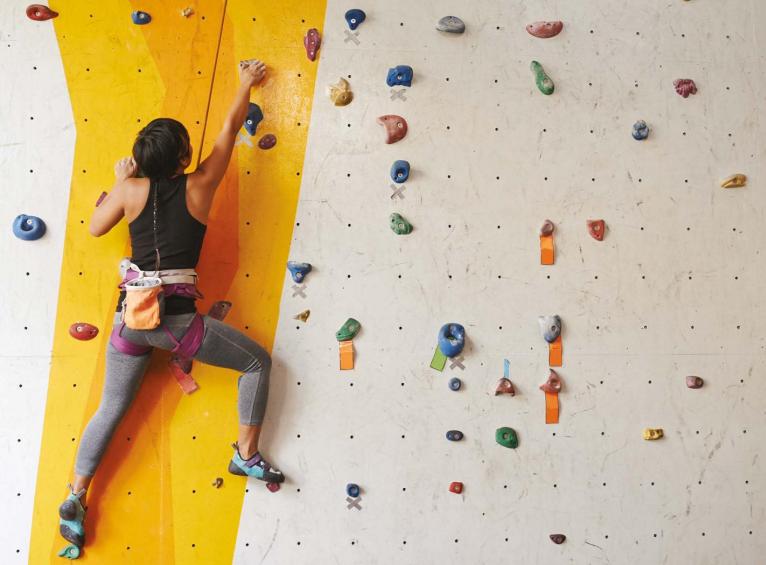Hands up – how many times have you walked past the climbing wall in your gym without so much as a double glance? Yeah, us too. As children we’d have pushed and kicked our way past every kid at school for a chance to get on the wall before the end of break, but in recent years we’ve come to see the art of climbing as an activity for the boys. Perhaps because of the outdoor adventure aspect? Or maybe it’s the less than feminine attire of yesteryear that should shoulder the blunt of the blame? Either way, we’re pleased to report that this line of thinking is finally taking a turn in favour of women: rock climbing, both indoors and out, is now more popular, accessible, fun, and female-friendly than ever before. Recent evaluations show that 38 percent of women currently make up the International Federation of Sport Climbing and that doesn’t even include recreational climbers. So, what can you expect when you extend your reach? For starters a clearer mind, sharper focus and a toned silhouette! Here’s everything you need to know to get started…
A glossary of ascent
Even with all the basic knowledge down, we get that it can still be daunting to walk into a session where everyone knows what they’re doing, especially as climbers tend to reel off words that don’t make sense to anyone but them. That’s why we’ve compiled a list of terms to help get you in the groove.
Anchor: the point where a climber’s rope is securely attached to the rock or wall
Barn door: when a climber loses grip on one side and swings sideways as though on a hinge
Carabiner: an oval or d-shaped connector made from lightweight aluminium or alloy
Crater: hopefully you won’t be using this one too often – it’s used to describe a fall where a climber hits the ground with significant force
Gripped: when a climber is frozen with fear
Pig: also known as a haul bag – it’s a large, robust bag used to carry food, water and equipment on a long climb
Rack: the full set of gear needed for a route
Rappel: using a rope to descend from a climb
Whipper: another fall, usually a very long one!
New heights
Climbing is one of those workouts that does wonders for your entire frame. Just like dancers and gymnasts, climbers aim for a high strength-to-body weight ratio, but they don’t have to do much extracurricular in order to reach their desired fitness level (oh no!). On its own, rock climbing promotes the perfect balance of muscle and fat by seamlessly blending cardio and strength training into one session: constant movement keeps your heart rate pumping while pulling, twisting and pushing motions engage more muscles than you ever knew you had!
Oh, and did we mention it’s one of the most effective ways to strengthen your core? Professional rock climber Sasha Digiulian explains it best: “Your core and your hips are essentially what drive your power and provide balance,” she says. “Your core connects your upper- and lower-body movements, improving your ability to engage while on the wall, so every time you climb, your core gets stronger.”
Just one hour of grappling can burn upwards of 400 calories (where do we sign up?!) and it’s a great workout for the mind as well. As you embark upon a new route, it’s up to you to figure out the safest and most accessible path to the top. Of course, what seemed like a good idea on the floor can often change when you’re on the wall, meaning that you’ll be constantly re-evaluating your position and making careful decisions about where to step next. This will fine-tune your problem-solving skills as well as improve your focus and your ability to perform under pressure.
As cold, dark days start to outnumber the sun, it might make more sense to start your training inside. But if you’ve got a penchant for outdoor pursuits, all is not lost! You can either go hardcore and train through the wet and cold or you can focus on building your skills indoors so you’re ready to take to the cliffs come spring.
From the ground up
There are three types of climbing to get acquainted with. Here’s the lowdown on each one
- Easy does it: Bouldering
Bouldering is a form of rock climbing that doesn’t require the use of ropes or harnesses. It usually takes place on a wall no higher than six metres to prevent injury in case of falls. It can be done without any equipment, but most people use climbing footwear, chalk and mats for added safety. It’s a perfect starting point for beginners, especially those who are slightly nervous about taking to the ropes straight away.
- Taking the plunge: Top-roping
This is the most common style of climbing at indoor practice walls and although slightly more complex than bouldering, it’s still a great starting point for newbies. Climbers attach themselves to the end of a rope which passes through an anchor at the top of the wall and then down to a spotting partner on the floor. As the climber ascends, their partner pulls in the slack rope in such a way that if the climber were to let go, they would be held in place on the wall.
- Top of the world: Lead climbing
Most people work their way up to lead climbing through years of practice. The method involves the use of a rope which you clip into the wall as you ascend. Climbing this way can feel nerve-racking as your safety is dependent on your clipping points. If you were to place your rope into an unstable piece of rock, for example, your safety net may not hold if you were to lose your footing. While indoor lead climbs are generally safe (shout out to pre-established, secure clipping points), outdoor practice can present a number of dangers and risks and should not be undertaken without the assistance of a professional who is acquainted with your chosen terrain.
Meet the experts
Vanessa O’brien
Vanessa is a Guinness World Record Holder as the fastest female to climb the Seven Summits and the quickest woman to complete the Explorer’s Grand Slam. She has reached the last degree of both the North and South Poles, and not content there, in 2017, became the first British woman to successfully scale and descend K2. Find out more about her at vobonline.com
Shauna Coxey
Shauna has won countless international competitions and came second in the BT Sport Action Woman of the Year Awards 2014. She is head coach of the Royal Air Force Climbing Team, organiser of the Women’s Climbing Symposium and an experienced route setter. She represented Great Britain in this year’s Olympic Games.
How did you get into climbing?
S: I started climbing at a local wall at the age of four, after seeing a female free-climber on TV. I quickly became obsessed with the sport and asked my father to take me as often as possible. At the age of seven, I started competing and became a member of the GB climbing team at the age of 11.
V: As a former businesswoman, it took a recession and looking for a challenge for me to discover climbing and all the different types and styles. To narrow them down, there are four main categories; advanced trekking, alpine mountaineering (mixed rock, snow and ice climbing), rock climbing and ice climbing.
What specialist equipment do you need?
S: When you very first start climbing, I wouldn’t worry about buying equipment as you can hire everything. For bouldering you don’t even need a partner! It’s super-safe and a great way to build confidence and get fit.
V: This depends on the terrain being tackled. For alpine climbing, you’ll need a pair of crampons, a helmet (get one that fits) and a harness. An ice axe, carabiner hooks and an ascender (used for ascending on a rope) are also climbing essentials. A well-fitting backpack, which can be tricky to find for women, is also crucial.
How does competitive climbing work?
S: It’s brilliant that our sport has finally made it to this year‘s Olympic Games. There are three different disciplines to competition climbing. Bouldering, lead climbing and speed climbing. The event is a combination of the three disciplines and there would be one overall winner for male and female. For some, bouldering is the ultimate expression of climbing – no ropes, no gear, just the joy of pure movement, in relative safety, not too high above the ground. Bouldering is my main focus at the moment but I originally started competing in lead climbing, where you’re tied to a rope and able to climb much higher.
Climbing looks like hard work – how fit do you need to be?
V: Your fitness regime depends on your goal. My rule is the higher you plan to climb, the more important cardiovascular exercise becomes and the less important weight lifting is, as where the air is thin oxygen is limited, and the brain, lungs and muscles all compete for it. Overall, I’d suggest focusing on cardiovascular exercises to improve your strength and core. Plus stretching, which is equally important but is often neglected. Don’t over-train and ensure you have rest days so that the body can repair itself. As for nutrition, I eat smaller portions more frequently to maintain energy levels and try to get between seven and eight hours sleep. Finally, water! Try to finish a 1.5 litre bottle every day – no exceptions. I also take electrolytes, either directly or via sports drinks.
What advice would you give to those with fears to conquer?
S: Climbing is a very social and fun sport. The climbing community is incredibly relaxed and there is always a great atmosphere. It’s so easy to get into, especially bouldering. You can book an induction course at your local climbing centre and there are usually beginner coaching classes and ladies’ nights that you can go along to.
V: Focus on what you can control. You can’t control the weather, avalanches, earthquakes or rock falls. Being scared is natural but I keep calm by reminding myself I’m attached to a sturdy mountain.
Secondly, I climb more slowly the higher I go because of thinner air, so I’m actually more in control. And finally, not all climbs are sheer drops so the gradual change in height and surroundings as you twist and turn is less dramatic.



















